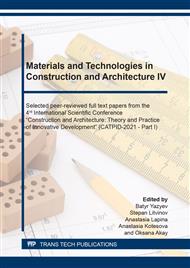p.73
p.81
p.93
p.101
p.109
p.115
p.121
p.127
p.133
Study of the Relationship between Concrete and its Reinforcement Elastic-Plastic Characteristics
Abstract:
The relationship between the elastic-plastic properties of concrete and its ability to resist the external loads and internal stresses effects arising under the influence of aggressive environmental factors has been studied. In concrete, micro-and macrocracks are filled with air and a liquid phase migrates with periodic environmental temperature, therefore, humidity changes. When the structure is compacted by crystalline hydrate neoplasms arising from supersaturated solutions, their surface increases and, correspondingly the part of water hydraulically bound to it also increases which changes its mobility with temperature. This entire system of interphase and single-phase structural bonds and interactions in concrete changes with fluctuations in humidity, cooling, and especially during phase transitions during freezing. The research found that the introduction of hydraulic additives into the binder, which carry a negative charge on their surface, leads to a charge change of the material structure pore space. The penetration kinetics of aggressive environments, adsorption interaction with the cement stone capillaries surface has been studied.
Info:
Periodical:
Pages:
109-114
Citation:
Online since:
August 2021
Authors:
Price:
Сopyright:
© 2021 Trans Tech Publications Ltd. All Rights Reserved
Share:
Citation:


